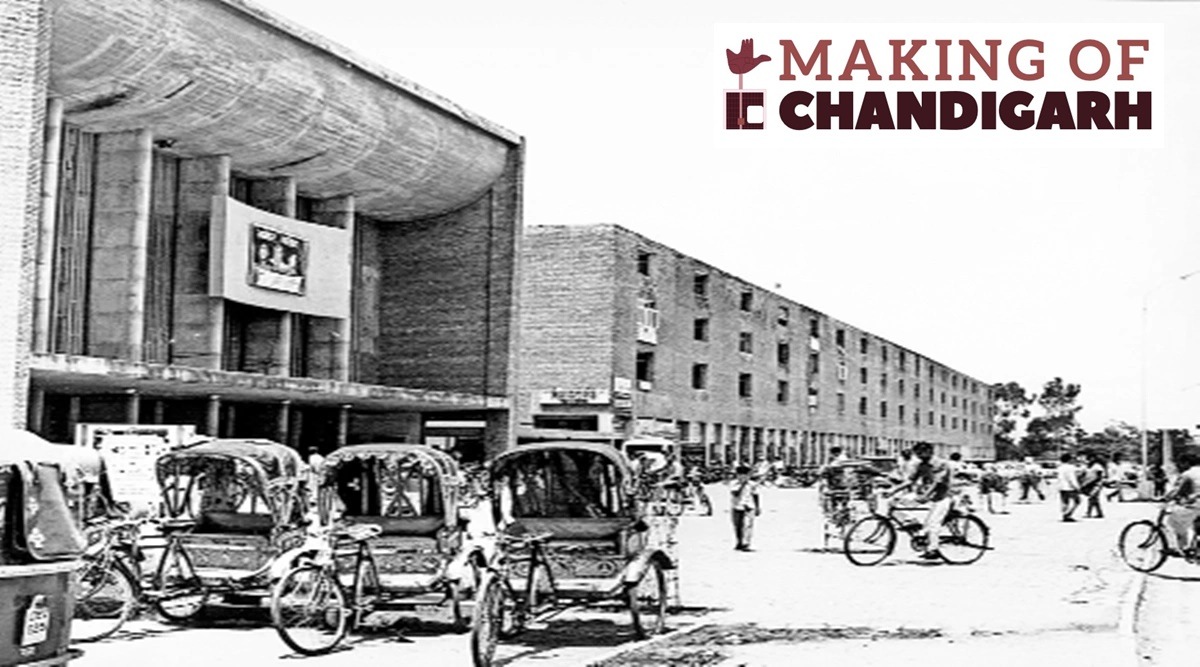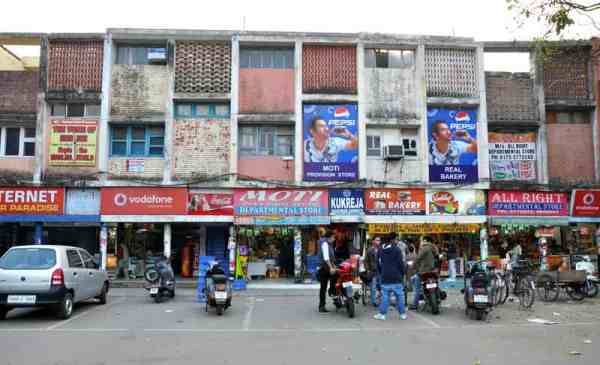Updated: February 6, 2022 1:42:16 pm
 Historic photograph of city centre showing V-4 street in front of Neelam Cinema. Chandigarh College of Architecture
Historic photograph of city centre showing V-4 street in front of Neelam Cinema. Chandigarh College of Architecture Written by Grishma Patle and Shreya Kashyap
Inside the grid iron pattern of Chandigarh’s plan exists the essence of a neighbourhood design that aimed at becoming self-sufficient sectors for life inside the city.
The neighbourhood unit created in the Mayer plan contained different typologies of housing, a local shopping bazaar, primary and middle schools and parks. Some scholars claim that a sector size was conceived by dividing into clusters of about 150 families, taking inspiration from the normal conventional settlement observed in Punjab.
Le Corbusier’s arrival on the scene solidified the organic plan into a grid-iron arrangement while retaining the basic unit of a ‘sector’. In a Corbusier neighbourhood, the V4s, that is the ‘Bazaar street’, bisect each sector, with houses located on the north and shops on the south. This also unified them in an east to west direction. They are intentionally open to a variety of traffic but permit relatively slow movement. With introverted planning, the V4s became the focus of life and the catalyst for social interaction between neighbouring sectors.
V4 streets cater to the shopping the needs of the sectors. Eliminating the necessity of frequent street crossing and bringing some irregularities in the grid, they support various functions and services in a stretch of about 800 metres. While the sectors themselves may have been planned as a ‘city within a city’, the lattice of shopping streets, pedestrian pathways and green belts weave the social fabric of Chandigarh together.
Moreover, the network also accommodates two types of shopping facilities — the formal and the informal. The buildings along the V4 streets are at a human scale, integrating with the street environment and enhancing the pedestrian experience.
Jane Drew, the British Architect on the team, identified the markets as the ‘hub’ of the sector.
 The network also accommodates two types of shopping facilities — the formal and the informal.
The network also accommodates two types of shopping facilities — the formal and the informal. A proper scale had to be established and for this, architectural controls were laid down. Relatively small shops-cum-flats were introduced where the ground floor had shops with two floors of living quarters above. Bazaars also incorporate rows of small one-storey shops. However, most of the buildings follow the original shops-cum-flats design with the two upper floors adapted for office use. It was designed in a way that two inset verandas would illuminate while a windowless front brick facade would provide privacy.
Additional privacy was ensured by a tall parapet around the roof terrace. Following the established pattern of Chandigarh, all shops were behind a continuous veranda, screening from the sun and rain, with advertisement panels on the ground floor only.
The basic scheme of the market spaces was established in the designs of Sector 22, the first sector to be built in the city. Two kinds of shop designs gained prominence in the Sector — one employing red brick facing and white trim; the other using a cream, painted plastered surface whilst masking the balconies of the upper levels with brick jaalis. Although the façade treatment of shopping areas varies somewhat throughout Chandigarh, all bazaar buildings adhere to the basic scheme established in the designs produced by Jane Drew in Sector 22.
Sector 23, developed almost simultaneously with Sector 22, also assimilates green spaces into the market space. An existing clump of trees was fringed by shops to provide shade and space for an open-air fruit and vegetable market.
Each sector market was supposed to incorporate all type of merchandise and facilities within to create a self-sufficient cluster. Over time with a change in legislation, the usage of the shops was made flexible as a result now the sector markets are transforming into specialised markets.
For instance, the sector 8 market is a food-hub today, sector 27 has turned into an automotive repair and service market and sector 11 market serves as a medical market especially due to the close proximity to the PGI. Driven by gradual legislative decisions many people have also altered their residences along the V4 streets into mixed use properties. Furthermore, advertisement panels which were originally only permitted on the ground floor are besmirching the entire façade and changing the architectural vocabulary of bazaars.
The design of the internal markets had a sense of order which defined each sectors functional character. Factors, like the original architectural controls partially relaxed, growing population, increased demands for commercial space and changing shopping trends, have significantly altered the market character of the V4 street.
What must be considered at this point is that even though the change in market trends needs to be accommodated, the original order and aesthetic character of the markets need to be conserved through conscious legislative and design decisions.
(Grishma Patle is assistant professor and Shreya Kashyap is a second-year student in Chandigarh College of Architecture. The article is edited by Saumya Sharma, assistant professor.)
- The Indian Express website has been rated GREEN for its credibility and trustworthiness by Newsguard, a global service that rates news sources for their journalistic standards.

